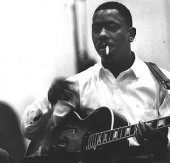Montgomery was born in Indianapolis, Indiana, United States. He came from a musical family, in which his brothers, Monk (string bass and electric bass) and Buddy (vibraphone, and piano), were jazz performers. Although he was not skilled at reading music, he could learn complex melodies and riffs by ear. Montgomery started learning guitar in his late teens, listening to and learning recordings of his idol, the guitarist Charlie Christian. He was known for his ability to play Christian solos note for note and was hired by Lionel Hampton for this ability.
Montgomery is often considered the greatest of modern Jazz guitarists. Following the early work of swing/pop/pre-bop guitarist Charlie Christian and gypsy-jazz guitarist Django Reinhardt, Wes arguably put guitar on the map as a bebop or post-bop instrument. Although Johnny Smith was the guitarist in the original New York Bebop scene, and Tal Farlow also made amazing contributions in the 1950's to bebop guitar, each of these men curtailed their own output in the 1960s, creating a vacuum that Montgomery naturally filled with virtuousic playing. While many Jazz players are regarded as virtuosos, Montgomery was unique in his wide influence on other virtouosos who folowed him, and in the respect he earned from his contemporaries. To many, Montgomery's playing defines jazz guitar and the sound that many try to emulate. It is hard to argue there was a more influential Jazz guitarist than Wes Montgomery.
Montgomery played with Lionel Hampton early in his career, and then took a break from full time playing to care for his family. He continued to play nights in local clubs. Cannonball Adderly heard Montgomery in a local Indiana club and was floored. He helped sign Montgomery to a recording contract and recorded with him on his Pollwinners album. Montgomery recorded with his brothers and various other group members, including the Wynton Kelly Trio which previously backed up Miles Davis.
John Coltrane asked Montgomery to join his band after a Jam session, but Montgomery continued to lead his own band. Boss Guitar seems to refer to his status as a guitar-playing bandleader. He also made contributions to recordings by Jimmy Smith.
Jazz purists relish Montgomery's recordings up through 1965, and sometimes complain that he abandoned hard-bop for pop jazz towards the end of his career. Even in his later years, his playing is still stellar, and it is arguable that he gained a wider audience for his brilliant earlier work with his soft Jazz from 1965-1968. During this late period he would occasionally turn out original material alongside jazzy orchestral arrangements of pop songs. In sum, this late period earned him considerible wealth and created a platform for a new audience to hear his earlier recordings.
Montgomery often approached solos with a three-tiered approach. He would often begin a repeating progression with single note lines, likely derived from scales or modes. After a fitting number of sequences, he would play octaves for a few more sequences, and then crescendo his solos with arpeggiated chords before finishing.
The use of octaves (playing the same note on two strings one octave apart) for which he is widely known, became known as "the Naptown Sound". Montgomery was also an excellent "single-line" or "single-note" player, and was very influential in the use of block chords in his solos. His playing on the jazz standard "Lover Man" is an example of his single-note, octave and block chord soloing. ("Lover Man" appears on the Fantasy album The Montgomery Brothers.)
Instead of using a guitar pick, Montgomery plucked the strings with the fleshy part of his thumb, using downstrokes for single notes and a combination of upstrokes and downstrokes for chords and octaves. This technique enabled him to get a mellow, expressive tone from his guitar. George Benson, in the liner notes of the Ultimate Wes Montgomery album, wrote that "Wes had a corn on his thumb, which gave his sound that point. He would get one sound for the soft parts, and then that point by using the corn. That's why no one will ever match Wes. And his thumb was double-jointed. He could bend it all the way back to touch his wrist, which he would do to shock people."
He generally played a Gibson L-5CES guitar. In his later years he played one of two guitars that Gibson custom made for him. In his early years, Montgomery had a tube amp, often a Fender. In his later years he played a Standel.
